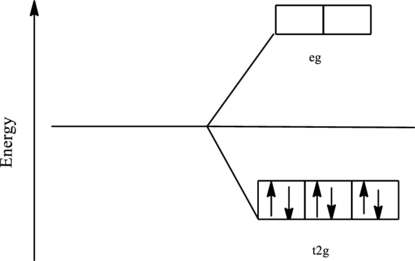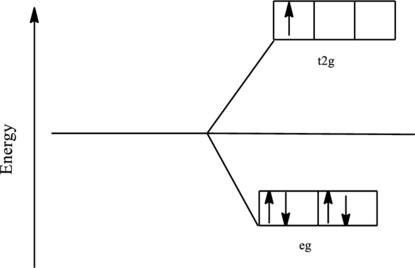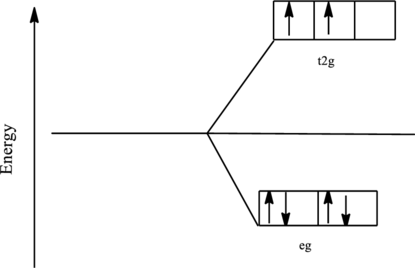
Concept explainers
Interpretation:
An explanation has to be given why when paramagnetic
Answer to Problem 9D.13E
If paramagnetic
Explanation of Solution
The oxidation number of iron in
The orbital energy level diagram for

Since, cyanide acts as a strong ligand in
The oxidation number of iron in
The orbital energy level diagram for

Since, cyanide acts as a strong ligand in
The oxidation number of iron in
The orbital energy level diagram for

Since, chloride ion is a weak ligand the electrons are filled according to the Hund’s rule in the d-orbitals and the number of unpaired electron in iron complex is one. Thus, it is paramagnetic complex.
The oxidation number of iron in
The orbital energy level diagram for

Since, chloride ion is a weak ligand the electrons are filled according to the Hund’s rule in the d-orbitals and the number of unpaired electron in iron complex is two. Thus, it is paramagnetic complex.
Want to see more full solutions like this?
Chapter 9 Solutions
CHEMICAL PRINCIPLES (LL) W/ACCESS
- Platinum(II) forms many complexes, among them those with the following ligands. Give the formula and charge of each complex. (a) two ammonia molecules and one oxalate ion (C2O42-) (b) two ammonia molecules, one thiocyanate ion (SCN-), and one bromide ion (c) one ethylenediamine molecule and two nitrite ionsarrow_forwardFor each d electron configuration, state the number of unpaired electrons expected in octahedral complexes. Give an example complex for each case. (Two answers are possible for some of these cases.) (a) d2 (b) d4 (c) d6 (d) d8arrow_forward
 Chemistry & Chemical ReactivityChemistryISBN:9781337399074Author:John C. Kotz, Paul M. Treichel, John Townsend, David TreichelPublisher:Cengage Learning
Chemistry & Chemical ReactivityChemistryISBN:9781337399074Author:John C. Kotz, Paul M. Treichel, John Townsend, David TreichelPublisher:Cengage Learning Chemistry: The Molecular ScienceChemistryISBN:9781285199047Author:John W. Moore, Conrad L. StanitskiPublisher:Cengage Learning
Chemistry: The Molecular ScienceChemistryISBN:9781285199047Author:John W. Moore, Conrad L. StanitskiPublisher:Cengage Learning Chemistry: Principles and ReactionsChemistryISBN:9781305079373Author:William L. Masterton, Cecile N. HurleyPublisher:Cengage Learning
Chemistry: Principles and ReactionsChemistryISBN:9781305079373Author:William L. Masterton, Cecile N. HurleyPublisher:Cengage Learning Chemistry: Principles and PracticeChemistryISBN:9780534420123Author:Daniel L. Reger, Scott R. Goode, David W. Ball, Edward MercerPublisher:Cengage Learning
Chemistry: Principles and PracticeChemistryISBN:9780534420123Author:Daniel L. Reger, Scott R. Goode, David W. Ball, Edward MercerPublisher:Cengage Learning ChemistryChemistryISBN:9781305957404Author:Steven S. Zumdahl, Susan A. Zumdahl, Donald J. DeCostePublisher:Cengage Learning
ChemistryChemistryISBN:9781305957404Author:Steven S. Zumdahl, Susan A. Zumdahl, Donald J. DeCostePublisher:Cengage Learning Chemistry: An Atoms First ApproachChemistryISBN:9781305079243Author:Steven S. Zumdahl, Susan A. ZumdahlPublisher:Cengage Learning
Chemistry: An Atoms First ApproachChemistryISBN:9781305079243Author:Steven S. Zumdahl, Susan A. ZumdahlPublisher:Cengage Learning





